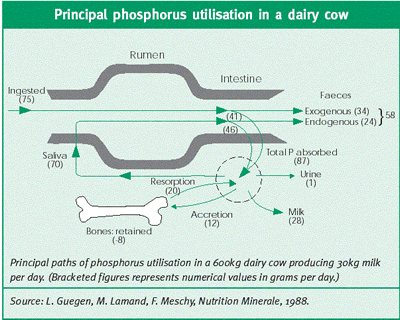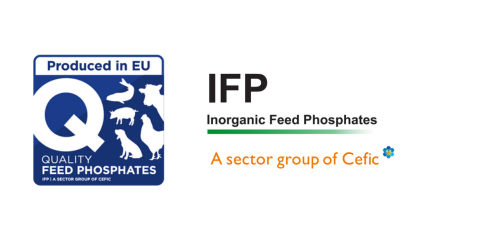In contrast to monogastrics, ruminants have a digestion system whereby micro-organisms in the rumen produce enzymes to break down the phytate phosphorus of plant material. Phosphorus from these sources is, therefore, better suited to ruminants but, as a general rule, it is still utilised by the animal to a lesser extent than the phosphorus provided from inorganic sources.

The ruminant’s nutritional requirement is dictated by the needs of the microbial population in its rumen, with the phosphorus being necessary for cellulose digestion and protein synthesis.
The main source of phosphorus for these microbes is the phosphorus that is recycled by the saliva, a particular characteristic of ruminants.
If the phosphorus supply is not sufficient, recycling of phosphorus in the saliva diminishes and the cellulose digestion function of the rumen bacteria is affected, causing a decrease in the feed digestibility, reduced feed intake and resulting lower production.
The phosphorus is mainly absorbed in the small intestine and urinary excretion of phosphorus is very low. Endogenous losses, principally non re-absorbed salivary phosphorus, make up the greater fraction of the faecal phosphorus excretion.
Phosphorus requirements
Comparison of the requirements of ruminants with the levels of phosphorus provided by normal pasture and plant feed material shows that, in a similar fashion to monogastrics, phosphorus supplementation is necessary on a regular basis to satisfy the needs of the animal.
Although phosphorus supplementation is generally accepted for winter rations, there is still a fairly widespread belief among livestock producers that pasture alone is capable of satisfying the animals’ requirements during the summer months.
However research has shown that when mineral supplementation is not provided to grazing cattle, lack of phosphorus has often been shown to be the most prevalent mineral deficiency, depending on the needs of particular animals and the type of forage used.
|
Calcium and phosphorus content of grassland compared with requirements of ruminants |
||||||
|
Total content |
Total intake 15kg herbage DM |
Daily Requirement |
||||
|
Dairy cow 600kg 35kg milk/day |
Beef stock 400kg 1.4kg gain/day |
|||||
|
Mean (g/kg DM) |
Range (g/kg DM) |
Mean (g) |
Lowest value (g) |
(g) |
(g) |
|
|
Calcium |
5.9 |
4.1 - 7.1 |
118 |
82 |
85 |
56.4 |
|
Phosphorus |
3.9 |
1.7 - 5.6 |
58.5 |
34 |
93 |
36.0 |
|
Sources: after AFRC |
||||||
Phosphorus supplementation
Regular supplementation is necessary to meet a ruminant’s daily need for phosphorus, even in the maintenance state. Any requirement on top of this is primarily dictated by the need to compensate for mineral loss during milk and foetus production or to permit fast growth in young animals.
For instance, during pregnancy or at the start of lactation, dairy cows are incapable of satisfying their total requirement for phosphorus and calcium from the feed alone, no matter what its level of nutrients.
They therefore draw on their reserve in the bones to meet their need. This reserve subsequently needs to be reconstituted at a more favourable time, such as during the second half of lactation, when the animal’s daily phosphorus requirement is lower.
